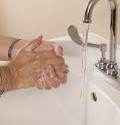Author Interviews, Hand Washing, Infections, Pulmonary Disease, Respiratory / 16.10.2018
Nose-Picking Can Spread Pneumonia
MedicalResearch.com Interview with:
 Dr Victoria Connor
Clinical Research Fellow
Liverpool School of Tropical Medicine and Royal Liverpool Hospital
MedicalResearch.com: What is the background for this study? What are the main findings?
Response: Pneumococcus is a bacteria which is very common and causes lots of different infections (pneumococcal disease). Infections can be non-invasive or invasive. Non-invasive diseases include middle ear infections, sinusitis and bronchitis. Invasive infections including chest infection (pneumonia), infections of brain and spinal cord (meningitis) and blood infections (sepsis).
Invasive pneumococcal infections is a major cause of death around the world and in the UK, is estimated that is responsible for 1.3 million deaths in children under 5 annually. Pneumococcal disease causes more deaths in low and middle income countries where approximately 90% of pneumonia deaths occur.
Pneumococcus also is commonly carried (colonises) the nose/throat of children and adults. This colonisation is important to understand as it is the main source of the bacterial transmission and is also the first step in pneumococcal infections.
The understanding of transmission of pneumococcus is currently poor. It is generally thought that transmission occurs through breathing in the respiratory sections of someone carrying pneumococcus in their nose which are infected with pneumococcus.
However more recently studies especially in mice have shown that there may be a role of hands or other objects as vehicles for the transmission of pneumococcus.
(more…)
Dr Victoria Connor
Clinical Research Fellow
Liverpool School of Tropical Medicine and Royal Liverpool Hospital
MedicalResearch.com: What is the background for this study? What are the main findings?
Response: Pneumococcus is a bacteria which is very common and causes lots of different infections (pneumococcal disease). Infections can be non-invasive or invasive. Non-invasive diseases include middle ear infections, sinusitis and bronchitis. Invasive infections including chest infection (pneumonia), infections of brain and spinal cord (meningitis) and blood infections (sepsis).
Invasive pneumococcal infections is a major cause of death around the world and in the UK, is estimated that is responsible for 1.3 million deaths in children under 5 annually. Pneumococcal disease causes more deaths in low and middle income countries where approximately 90% of pneumonia deaths occur.
Pneumococcus also is commonly carried (colonises) the nose/throat of children and adults. This colonisation is important to understand as it is the main source of the bacterial transmission and is also the first step in pneumococcal infections.
The understanding of transmission of pneumococcus is currently poor. It is generally thought that transmission occurs through breathing in the respiratory sections of someone carrying pneumococcus in their nose which are infected with pneumococcus.
However more recently studies especially in mice have shown that there may be a role of hands or other objects as vehicles for the transmission of pneumococcus.
(more…)
 Dr Victoria Connor
Clinical Research Fellow
Liverpool School of Tropical Medicine and Royal Liverpool Hospital
MedicalResearch.com: What is the background for this study? What are the main findings?
Response: Pneumococcus is a bacteria which is very common and causes lots of different infections (pneumococcal disease). Infections can be non-invasive or invasive. Non-invasive diseases include middle ear infections, sinusitis and bronchitis. Invasive infections including chest infection (pneumonia), infections of brain and spinal cord (meningitis) and blood infections (sepsis).
Invasive pneumococcal infections is a major cause of death around the world and in the UK, is estimated that is responsible for 1.3 million deaths in children under 5 annually. Pneumococcal disease causes more deaths in low and middle income countries where approximately 90% of pneumonia deaths occur.
Pneumococcus also is commonly carried (colonises) the nose/throat of children and adults. This colonisation is important to understand as it is the main source of the bacterial transmission and is also the first step in pneumococcal infections.
The understanding of transmission of pneumococcus is currently poor. It is generally thought that transmission occurs through breathing in the respiratory sections of someone carrying pneumococcus in their nose which are infected with pneumococcus.
However more recently studies especially in mice have shown that there may be a role of hands or other objects as vehicles for the transmission of pneumococcus.
(more…)
Dr Victoria Connor
Clinical Research Fellow
Liverpool School of Tropical Medicine and Royal Liverpool Hospital
MedicalResearch.com: What is the background for this study? What are the main findings?
Response: Pneumococcus is a bacteria which is very common and causes lots of different infections (pneumococcal disease). Infections can be non-invasive or invasive. Non-invasive diseases include middle ear infections, sinusitis and bronchitis. Invasive infections including chest infection (pneumonia), infections of brain and spinal cord (meningitis) and blood infections (sepsis).
Invasive pneumococcal infections is a major cause of death around the world and in the UK, is estimated that is responsible for 1.3 million deaths in children under 5 annually. Pneumococcal disease causes more deaths in low and middle income countries where approximately 90% of pneumonia deaths occur.
Pneumococcus also is commonly carried (colonises) the nose/throat of children and adults. This colonisation is important to understand as it is the main source of the bacterial transmission and is also the first step in pneumococcal infections.
The understanding of transmission of pneumococcus is currently poor. It is generally thought that transmission occurs through breathing in the respiratory sections of someone carrying pneumococcus in their nose which are infected with pneumococcus.
However more recently studies especially in mice have shown that there may be a role of hands or other objects as vehicles for the transmission of pneumococcus.
(more…)







